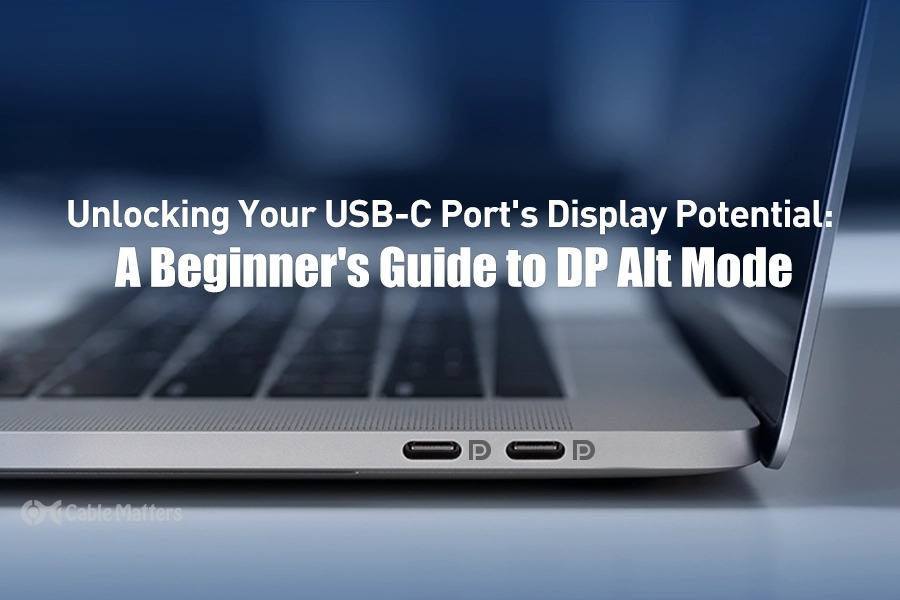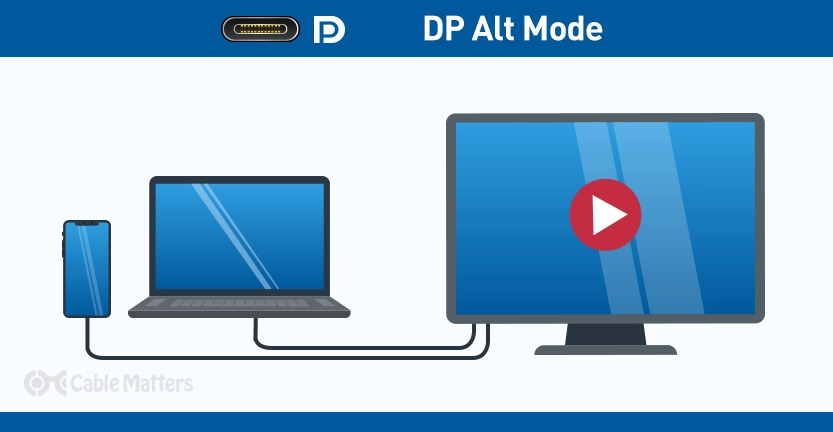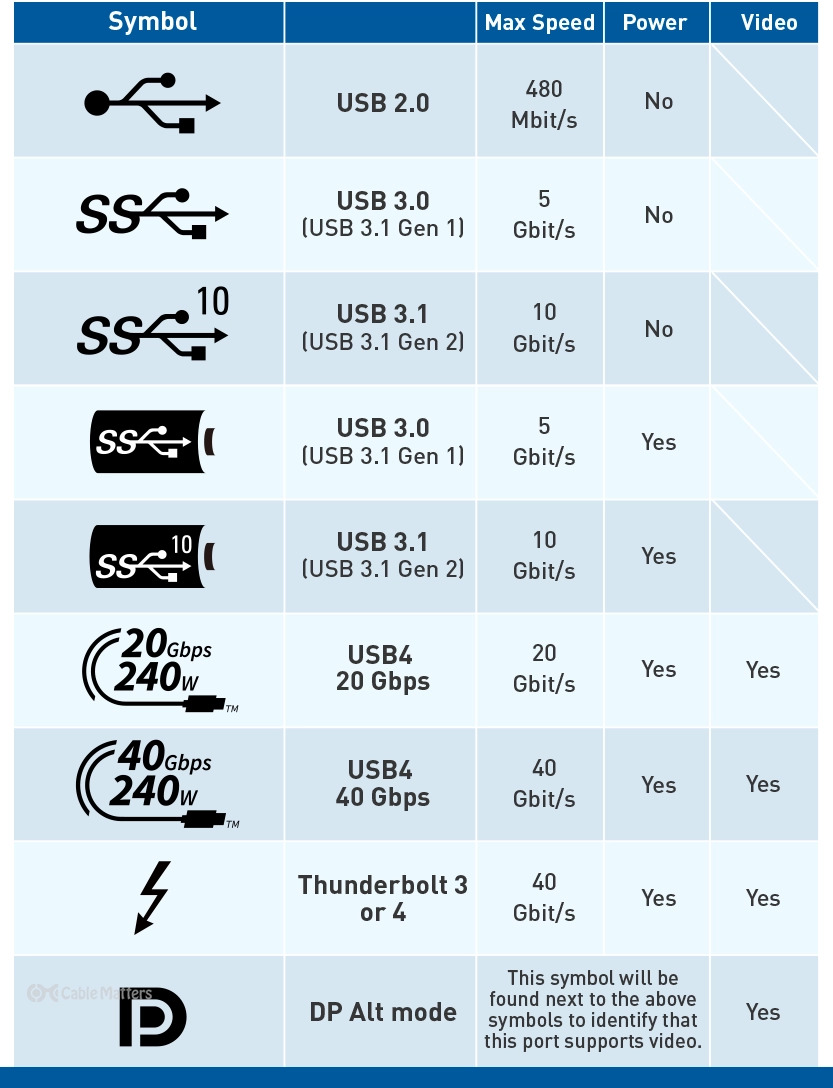
Navigation
In today's world, where versatility and convenience are paramount, the USB-C port stands out as a universal connector that allows us to seamlessly transmit high-resolution video and crystal-clear audio while providing power delivery and USB data transmission all through a single connector. But did you know that there's an incredible hidden supertechnology behind the video output capabilities of your USB-C port?
It's called DP Alt Mode, and it enables USB-C connectors to transmit and carry DisplayPort video signals. With a USB-C port that supports DP Alt Mode, you can extend or mirror your screen across various devices, from monitors and TVs to projectors and more. It simplifies your digital life, offering a streamlined solution for multimedia experiences, professional presentations, and gaming setups. This intuitive technology opens up new possibilities for productivity, entertainment, and creativity.
In this comprehensive guide, we will dive deep into the world of DP Alt Mode, exploring what it is, how it works, which cables and devices support it, and how to unleash its full potential. Whether you're a tech enthusiast, professional, or casual user, by the end of this article, you'll be equipped with the knowledge to unlock the power of DP Alt Mode and transform how you connect your devices.
What is DP Alt Mode?
In the world of high-resolution displays, DP Alt Mode plays a pivotal role. It is an alternative mode of operation for USB Type-C (USB-C) connectors that allows for the transmission of DisplayPort (DP) signals over the same connector. This innovative technology eliminates the need for a separate full-size DP connector, making it more convenient to connect devices to external displays.
DP Alt Mode, short for DisplayPort Alternate Mode, was introduced in 2014 by the Video Electronics Standards Association (VESA), the organization responsible for establishing and promoting display standards.
With its introduction, devices supporting DP Alt Mode gained the ability to transmit DP protocol signals natively from the USB-C port, enabling seamless integration of USB-C and DP functionalities. This means you can effortlessly connect your DisplayPort displays, projectors, or other compatible equipment to your USB-C devices, enabling high-quality video and audio output.
Traditionally, standard USB-C ports and cables could only deliver power and carry data for USB communication. They could not natively output video.
DP Alt Mode can work concurrently with other USB functions, allowing for data transfer, device charging, and video output simultaneously.

DP Alt Mode is highly versatile, supporting both passive and active cables, which means a wide range of devices can connect to external displays.
By incorporating DP Alt Mode, devices can achieve outstanding performance, including superior image quality, higher resolutions, refresh rates, and color depth. This makes it an invaluable technology for various applications, from gaming to graphic design and multimedia editing.
To ensure optimal connectivity, it is essential to use compatible cables and equipment that support DP Alt Mode. Additionally, verifying that your devices are equipped with the necessary hardware and software for DP Alt Mode is essential. Choosing high-quality cables and adapters is also crucial for reliable and seamless connectivity.
With DP Alt Mode enabled, a USB-C port can deliver full-sized DisplayPort video to an external monitor, TV, or projector without needing any adapters, dongles, or converters. This allows USB-C ports to drive high-resolution displays the same way dedicated HDMI or DisplayPort ports can.
DP Alt Mode is an optional feature that must be supported in both the USB-C port on a device like a laptop or phone, and in the USB-C cable connecting it to the display. Not all USB-C ports or cables support DP Alt Mode.
Benefits of DP Alt Mode
DP Alt Mode offers a multitude of benefits for users seeking to unlock the full display potential of their USB-C ports. By leveraging this powerful feature, users can experience enhanced visuals, greater flexibility, and streamlined connectivity.
Let's dive into the key benefits DP Alt Mode brings to the table:
Seamless Video Output
With DP Alt Mode, you can directly connect your USB-C port to a compatible display device without the need for additional adapters or converters. This eliminates the hassle of dealing with multiple cables and simplifies the process of connecting your device to an external monitor or television.
High-Quality Video and Audio
DP Alt Mode leverages the capabilities of DisplayPort technology, ensuring high-resolution video output and superior audio quality. Whether you're watching movies, playing games, or working on graphic-intensive tasks, DP Alt Mode allows you to enjoy sharp visuals, vibrant colors, and immersive sound on a larger screen.
Enhanced Productivity
DP Alt Mode enables users to extend their desktop workspace or mirror their device's screen to a larger display. This is particularly advantageous for professionals who require additional screen real estate for multitasking, video editing, or graphic design. With the ability to connect to multiple displays simultaneously, DP Alt Mode enhances productivity and fosters a seamless workflow.
Broad Compatibility
While DP Alt Mode is an optional feature, it is increasingly becoming a standard offering in many devices, including laptops, tablets, and smartphones. This compatibility ensures that users can connect their devices to a wide range of monitors, projectors, and televisions with ease, regardless of the manufacturer or model.
Future-Proof Connectivity
As technology continues to evolve, USB-C and DP Alt Mode offer future-proof connectivity options. By embracing this standard, users can rest assured that their devices will be compatible with the latest display technologies, ensuring that they can harness the full potential of emerging innovations for years to come.
As DP Alt Mode becomes increasingly prevalent, more devices will support this feature, driving interoperability and expanding the possibilities for seamless and high-quality display experiences. Embrace DP Alt Mode and unlock a world of enhanced visuals and connectivity.
DP Alt Mode vs. USB-C
While it's easy to assume that DP Alt Mode and USB-C are one and the same, they are not interchangeable terms. While they are closely intertwined, DP Alt Mode and USB-C are not the same thing. Let's uncover the relationship between these technologies and understand their individual significance.
USB-C is a connector standard that provides a universal interface for connecting various devices and supporting fast data transfer, power delivery, and audio/video signals. Also known as USB Type-C, it is a versatile and symmetrical connector that offers various functionalities beyond traditional USB connections.
When the term "USB-C" comes to mind, you're likely to focus on the physical connector itself. It boasts a smaller form factor and is capable of delivering higher data transfer speeds, supporting faster charging, and facilitating video and audio output. USB-C is becoming the standard port for many devices due to its compact size and flexibility.
While USB-C is a universal connector that supports various functionalities, DP Alt Mode specifically focuses on enabling display capabilities through the USB-C connector. It allows you to utilize your USB-C port as a display output port, offering greater flexibility and convenience while minimizing the clutter of multiple connectors.
DP Alt Mode is an optional feature that can be built into USB-C ports and cables, allowing them to transmit DisplayPort signals. It's essential to note that not all USB-C ports or cables support DP Alt Mode. Compatibility with DP Alt Mode depends on the specific device and cable.
To check whether your USB-C port supports DP Alt Mode, you can refer to the chart below:

Do All USB-C Cables Support DP Alt Mode?
While the USB-C connector provides a universal interface for various functions, not all USB-C cables support DP Alt Mode. DP Alt Mode requires a specific cable design and configuration to transmit DisplayPort signals alongside other USB-C functionalities.
To ensure compatibility with DP Alt Mode, it is crucial to choose a USB-C cable that is specifically designed for this feature. Full-featured USB-C cables undergo rigorous testing and are designed to handle the high bandwidth and signal integrity needed for video transmission.
On some USB-C cables, you will find the DisplayPort logo or mention of "DP Alt Mode" clearly displayed on the cable itself or its packaging. These logos or labels indicate that the cable has been thoroughly tested and verified for DP Alt Mode support.
USB4, the latest USB standard, incorporates the capabilities of Thunderbolt 3 and offers enhanced data transfer speeds and compatibility. USB4 and Thunderbolt 3 both support DP Alt Mode, ensuring that USB-C cables certified for Thunderbolt 3 are also compatible with DP Alt Mode. This compatibility means that users can leverage the enhanced video transmission capabilities of DP Alt Mode with USB4 and Thunderbolt 3 devices.
Furthermore, Thunderbolt 4, further refined the Thunderbolt technology by providing faster transfer speeds, improved performance, and stricter standards for device compatibility. Thunderbolt 4 also supports DP Alt Mode, ensuring that USB-C cables certified for Thunderbolt 4 can seamlessly transmit DisplayPort signals alongside other Thunderbolt functions.
Thunderbolt 5, the latest advancement in Thunderbolt technology, leverages cutting-edge USB, DP Alt Mode, and power delivery innovations to enhance data transfer speeds, expand support for higher resolutions and refresh rates on external monitors, and elevate charging and power delivery capabilities. As a result, Thunderbolt 5 is poised to become the go-to premium connector for a wide array of devices once it reaches widespread availability.
Using USB-C cables without DP Alt Mode support will not enable video output from your USB-C port. Attempting to leverage DP Alt Mode with a cable that does not support it will result in a lack of video signal to the monitor or TV.
It's important to note that both ends of a USB-C to USB-C cable must support DP Alt Mode for successful video transmission. If either the device or the display does not support DP Alt Mode, video output will not be possible, even with a full-featured cable that supports DP Alt Mode.
To ensure a seamless DP Alt Mode experience, check the compatibility of your USB-C cable before proceeding. Consult the cable's packaging, product description, or manufacturer's specifications to confirm support for DP Alt Mode.
Conclusion
In summary, DP Alt Mode is an advanced technology developed by the Video Electronics Standards Association (VESA) that enables the transmission of DP signals over USB-C connectors. This groundbreaking approach enhances convenience, versatility, and performance, providing a foundation for future display connectivity advancements to be built upon.
DP Alt Mode itself is a significant advancement in connectivity technology that harnesses the power of USB-C to transmit DisplayPort signals. Understanding what DP Alt Mode is, how it functions, and ensuring compatibility with cables and devices are essential steps in unlocking its full potential. With the capability to simplify connectivity and deliver high-quality video output, DP Alt Mode is rapidly transforming the way we connect our devices.
Whether it's for work, entertainment, or creativity, DP Alt Mode enables seamless and high-quality video output, providing an enhanced user experience. Unleash the power of DP Alt Mode and experience a new level of connectivity today!
FAQ
What is DP Alt Mode?
DP Alt Mode, or DisplayPort Alternate Mode, allows USB-C connectors to transmit DisplayPort (DP) video and audio signals, alongside data and power delivery.
How does DP Alt Mode work?
It repurposes some USB-C connector pins to carry DisplayPort signals, enabling direct connection to displays without extra adapters or cables.
Do all USB-C ports support DP Alt Mode?
No. Support for DP Alt Mode is device-specific. Both the USB-C port on the device and the cable must support DP Alt Mode.
How can I tell if a USB-C cable supports DP Alt Mode?
Look for the DisplayPort logo or "DP Alt Mode" on the cable or its packaging. Cables certified for USB4, Thunderbolt 3, or Thunderbolt 4 often support it as well.
Can DP Alt Mode deliver high-resolution and high-refresh-rate video?
Yes. DP Alt Mode utilizes DisplayPort's capabilities to output high resolutions and refresh rates.
Is DP Alt Mode compatible with HDMI?
DP Alt Mode itself is not natively compatible with HDMI, but it can be converted to HDMI outputs using suitable adapters.